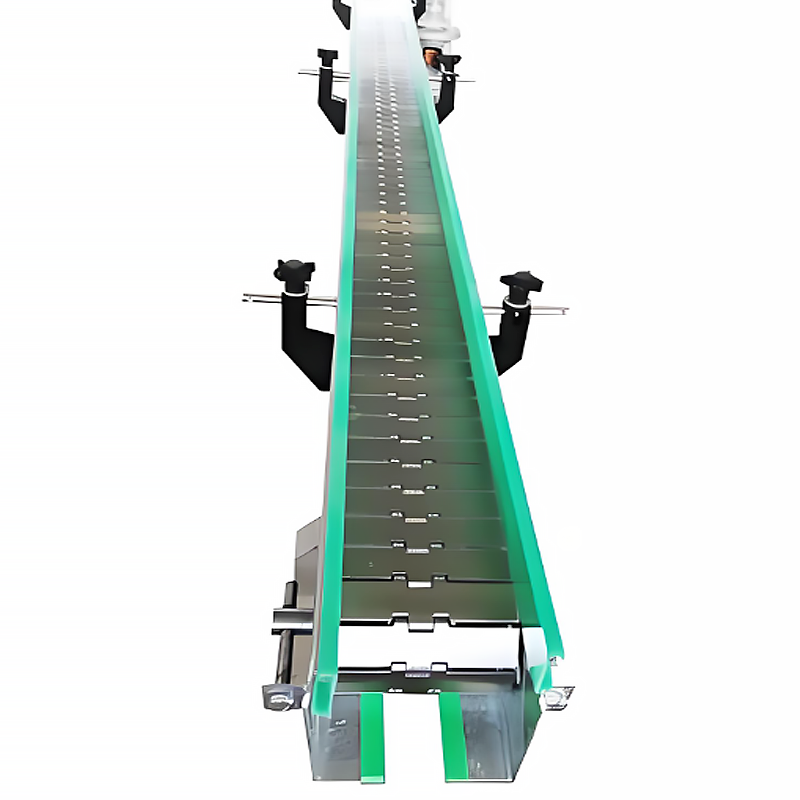An overhead chain conveyor is a type of material handling system used in industries for transporting goods along a suspended track. It consists of a continuous chain loop that moves items. Such as parts, assemblies, or products overhead through the production process or warehouse facility.
The chain runs through a series of trolleys or carriers that are attached to it, allowing items to be securely transported at various speeds and configurations.
Description
Aluminum Overhead Chain Conveyor
An overhead chain conveyor, known variably as a plate chain conveyor, chain plate conveyor, or simply chain conveyor. And it features a unique conveyor chain designed for flat-top applications. This versatile conveyor is employed for transporting a wide range of items.
It is including glass bottles, metal cans, plastic containers, packages, buffet items, and machine parts. It incorporates two primary types of flat-top chains: straight and side-bend, accommodating various mechanical equipment conveyance requirements.

Key Features of Overhead Chain Conveyor:
1. **Smooth Conveying Surface**: The chain plate offers a low-friction, seamless surface, ensuring a smooth transition of materials. Such as glass bottles, PET bottles, cans, and bags across conveyor lines.
2. **Material and Variety**: Crafted from stainless steel and engineering plastics, the chain plates come in numerous specifications. This diversity allows for customization based on material handling and process needs across different industries.
3. **Cleanability**: People can wash chain plates easily or submerge in water, making the equipment ideal for the stringent hygiene standards of the food and beverage industry.
4. **Flexible Configuration**: The conveyor design supports horizontal, inclined, and curved conveying within a single line, offering adaptable layout options.
5. **Simplicity and Stability**: With a straightforward design, the conveyor ensures stable operation and is easy to maintain.
Types of Flat-Top Chains:
Flat-top chains are differentiated into straight and side-bend varieties, enabling a range of mechanical conveying.
Mechanics and Design Principles:
The simple construction of a flat-top chain comprises a chain plate with side hinges and an axle pin. The side-bend variety innovates on this by:
1. **Enhancing Hinge Gaps**: Adjusting gaps between hinges allows for a bending angle between adjacent chain plates, facilitating larger turning angles through cumulative bends.
2. **Modifying Chain Plate Edges**: Beveling one side of the chain plate eliminates interference, enabling the chain to navigate curves efficiently.
3. **Incorporating Anti-Shift Plates**: These plates counteract inward chain movement during curves by addressing the radial force produced. It ensures smooth and stable turns.
Understanding these fundamental aspects and structural nuances of flat-top plate chain conveyors showcases their critical role in efficient material conveyance across diverse applications.
Application:
The overhead chain conveyor efficiently transports glass bottles, PET bottles, cans, and other materials with its flat, low-friction surface ensuring seamless material flow between conveyor lines. This conveyor utilizes a standard top plate chain as the bearing surface and a motor reducer for power transmission. That makes it ideal for fragile or delicate items such as glass bottles and cans, as well as various luggage items.
Moreover, the overhead chain conveyor finds widespread application in automating the conveyance, distribution, and in-line transportation of food, canned goods, pharmaceuticals, beverages, cosmetics, detergents, paper products, condiments, dairy products, and tobacco. By combining with chain or roller conveyors, it can facilitate corner conveyance to suit diverse production line requirements.
The innovative design allows for dynamic transitions of bottle or can bodies without material retention on the conveyor line. And it ensures efficient production processes and product quality whether conveying empty or full bottles under pressure or non-pressure conditions.
Selection of the Top Plates of Chain Conveyor
The selection of the top plate for a top plate chain conveyor primarily hinges on material and type considerations. The top plate can be crafted from either stainless steel or engineering plastic. Stainless steel top plates offer excellent corrosion and wear resistance, ideal for environments requiring high durability.
Conversely, engineering plastic top plates are lightweight, cost-effective, and suitable for general use. Both options ensure robustness and stability. So it ensures the conveyor operates reliably over extended periods.
Moreover, the design of the top plate chain conveyor also addresses requirements for continuous or intermittent operation. Meanwhile, it emphasizes smooth transmission and minimal deviation. Its modular structure facilitates easy assembly and disassembly of the top plate, reducing maintenance expenses. These features contribute to its widespread application across various industries. Such as food, beverages, cosmetics, and paper products, catering to diverse production environments.
When selecting the top plate for the conveyor, considerations also include the conveyor belt’s width, commonly available in widths like 63.5mm, 82.5mm, 101.6mm, and other specifications to suit different production lines. Additionally, factors such as equipment maintenance and care, including regular cleaning, organized storage of tools and accessories. So they are crucial to ensure optimal equipment performance and longevity.
Contact Us and Get A Quote
In conclusion, Toshine remains committed to advancing conveyor technology with a relentless focus on innovation, مصداقية, and efficiency. As industries evolve, our top plate chain conveyors stand at the forefront. Besides, it offers unparalleled durability and performance across diverse operational environments. We invite partners and stakeholders alike to join us in embracing these cutting-edge solutions.
Together, let’s elevate productivity, streamline operations, and forge a future where Toshine conveyors continue to set the standard for excellence.





